Analysis of Leadership Theories and Practices in Healthcare
VerifiedAdded on 2023/01/04
|14
|5081
|66
Report
AI Summary
This report delves into the critical aspects of leadership within the healthcare sector. It begins by defining leadership and its essential qualities, emphasizing the importance of leadership in managing the complexities of healthcare environments. The main body of the report explores the essentiality of leadership, highlighting the competencies required for effective management in healthcare, and discusses various leadership theories such as transformational, collaborative, conflict management, distributed, and ethical leadership. It further analyzes the stages of team development and the corresponding leadership styles, offering recommendations for open communication within healthcare teams. The report underscores the significance of leadership in fostering a collaborative and efficient work environment to improve patient care and organizational success. In essence, the report aims to provide a comprehensive understanding of how effective leadership can drive positive outcomes in healthcare.
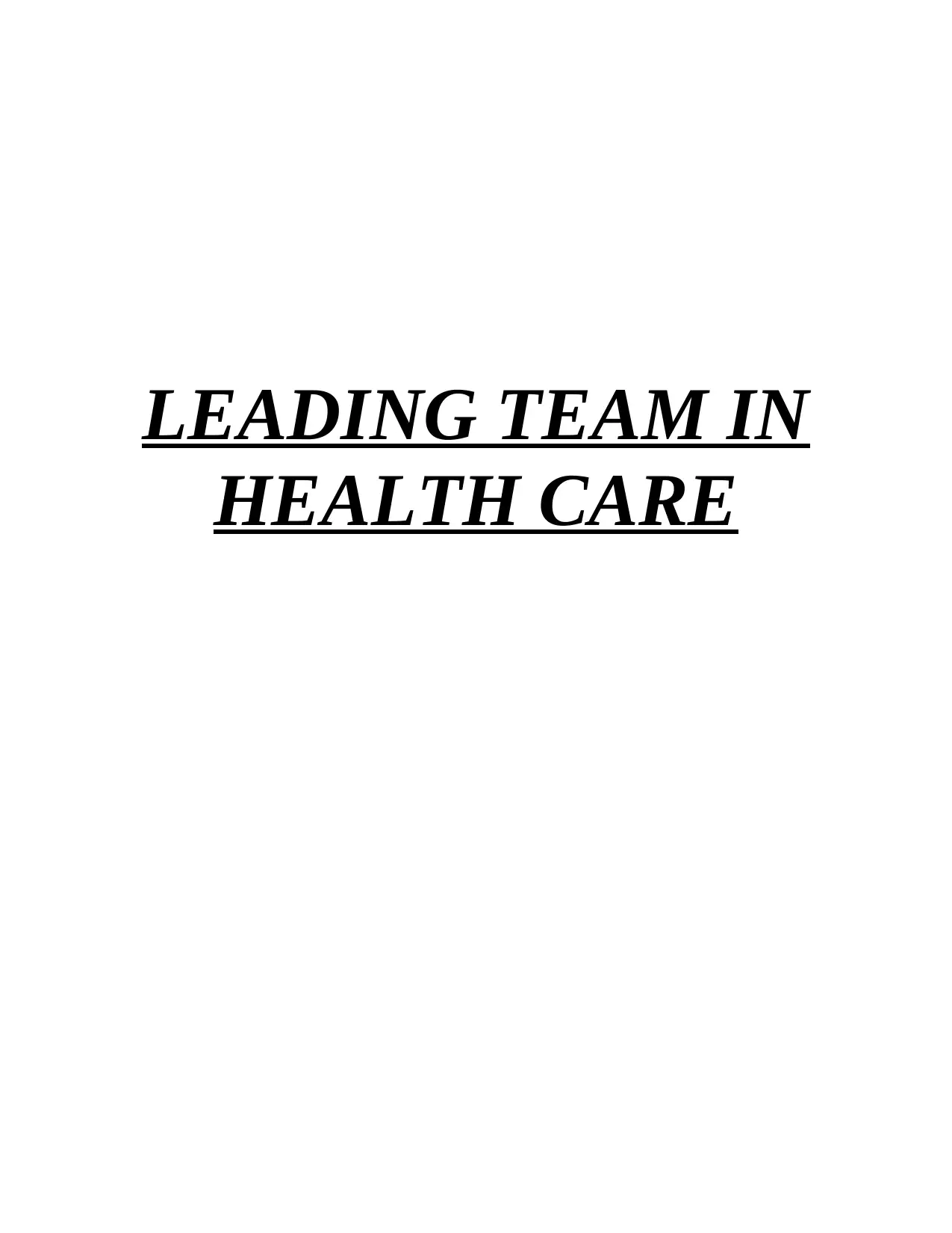
LEADING TEAM IN
HEALTH CARE
HEALTH CARE
Paraphrase This Document
Need a fresh take? Get an instant paraphrase of this document with our AI Paraphraser
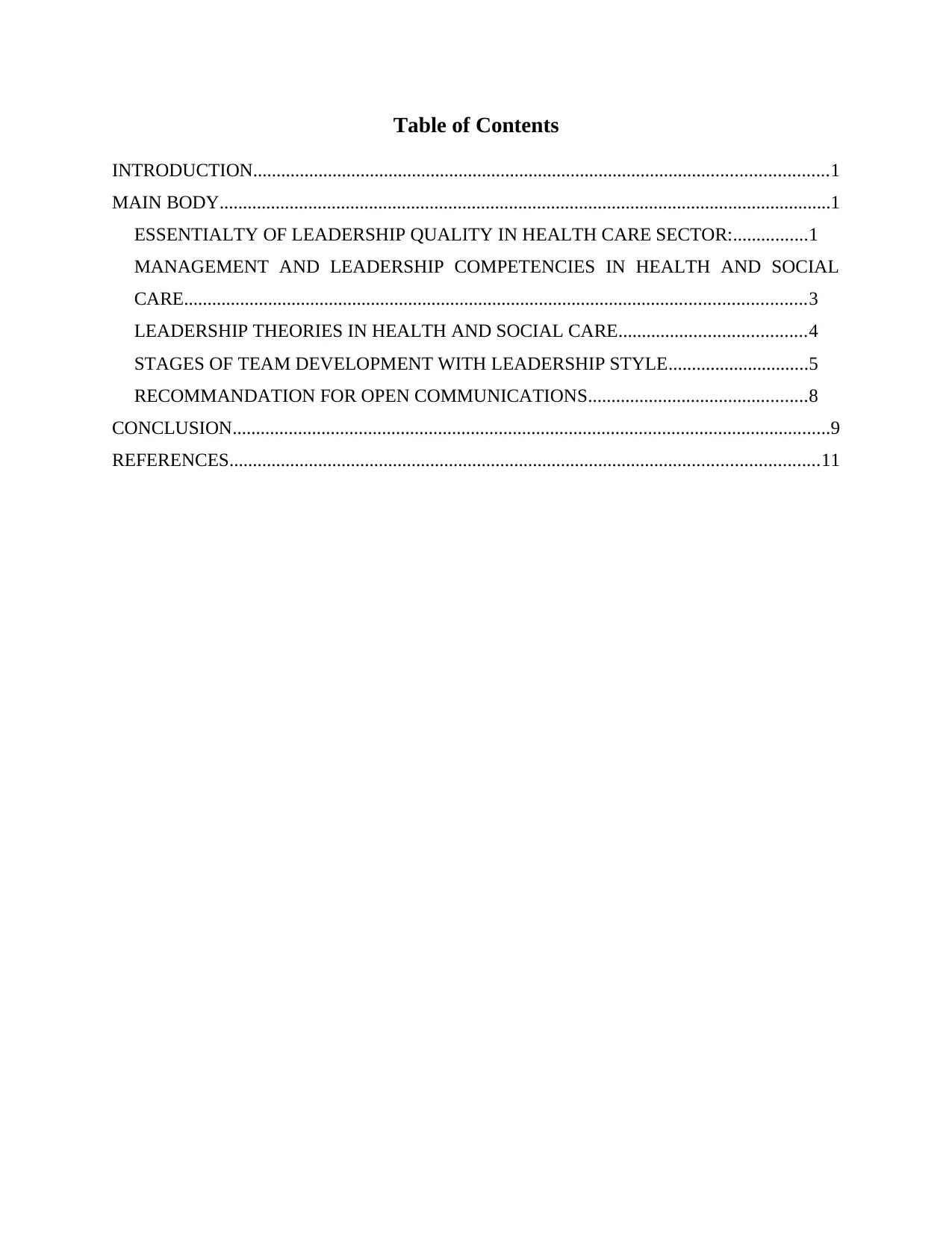
Table of Contents
INTRODUCTION...........................................................................................................................1
MAIN BODY...................................................................................................................................1
ESSENTIALTY OF LEADERSHIP QUALITY IN HEALTH CARE SECTOR:................1
MANAGEMENT AND LEADERSHIP COMPETENCIES IN HEALTH AND SOCIAL
CARE.....................................................................................................................................3
LEADERSHIP THEORIES IN HEALTH AND SOCIAL CARE........................................4
STAGES OF TEAM DEVELOPMENT WITH LEADERSHIP STYLE..............................5
RECOMMANDATION FOR OPEN COMMUNICATIONS...............................................8
CONCLUSION................................................................................................................................9
REFERENCES..............................................................................................................................11
INTRODUCTION...........................................................................................................................1
MAIN BODY...................................................................................................................................1
ESSENTIALTY OF LEADERSHIP QUALITY IN HEALTH CARE SECTOR:................1
MANAGEMENT AND LEADERSHIP COMPETENCIES IN HEALTH AND SOCIAL
CARE.....................................................................................................................................3
LEADERSHIP THEORIES IN HEALTH AND SOCIAL CARE........................................4
STAGES OF TEAM DEVELOPMENT WITH LEADERSHIP STYLE..............................5
RECOMMANDATION FOR OPEN COMMUNICATIONS...............................................8
CONCLUSION................................................................................................................................9
REFERENCES..............................................................................................................................11
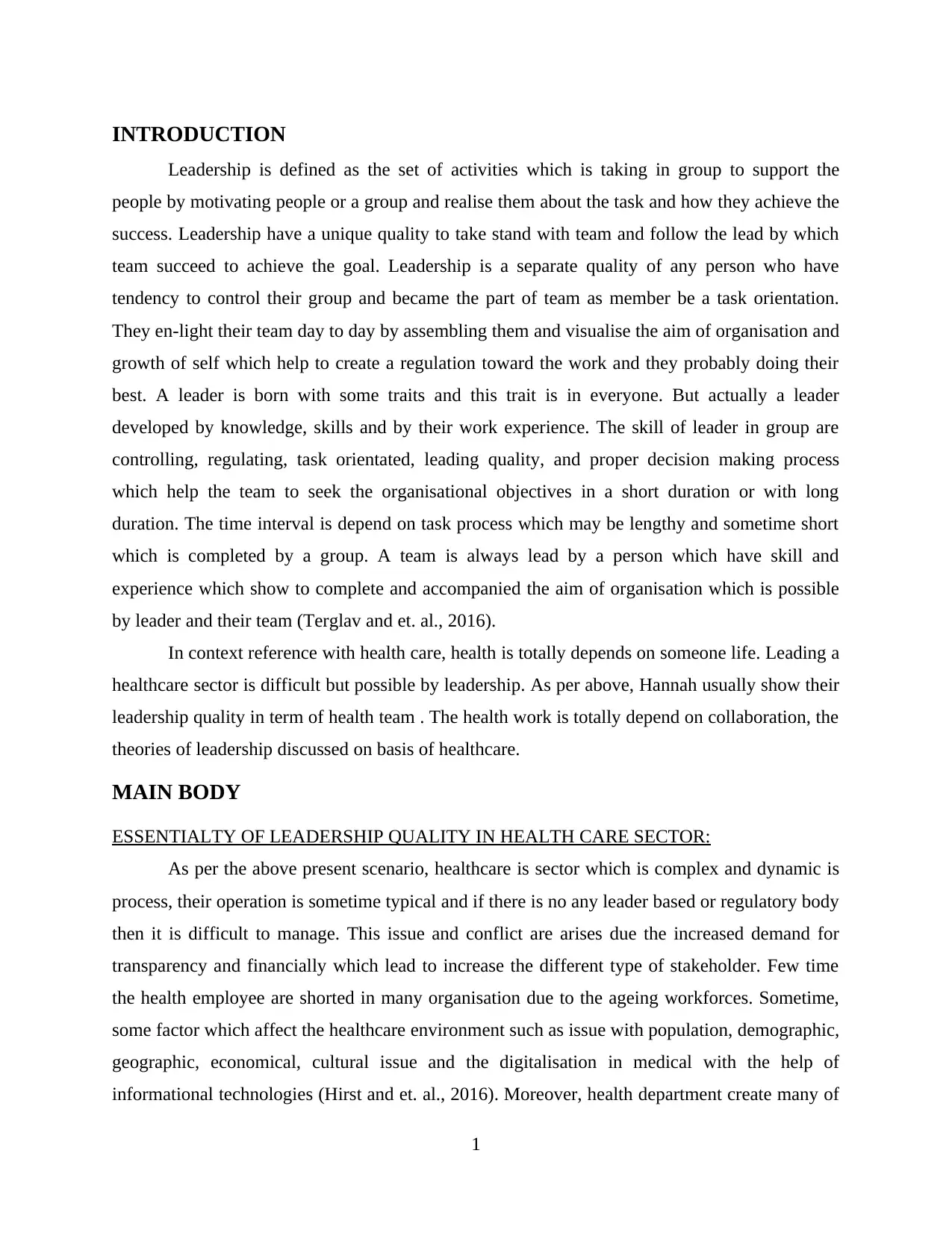
INTRODUCTION
Leadership is defined as the set of activities which is taking in group to support the
people by motivating people or a group and realise them about the task and how they achieve the
success. Leadership have a unique quality to take stand with team and follow the lead by which
team succeed to achieve the goal. Leadership is a separate quality of any person who have
tendency to control their group and became the part of team as member be a task orientation.
They en-light their team day to day by assembling them and visualise the aim of organisation and
growth of self which help to create a regulation toward the work and they probably doing their
best. A leader is born with some traits and this trait is in everyone. But actually a leader
developed by knowledge, skills and by their work experience. The skill of leader in group are
controlling, regulating, task orientated, leading quality, and proper decision making process
which help the team to seek the organisational objectives in a short duration or with long
duration. The time interval is depend on task process which may be lengthy and sometime short
which is completed by a group. A team is always lead by a person which have skill and
experience which show to complete and accompanied the aim of organisation which is possible
by leader and their team (Terglav and et. al., 2016).
In context reference with health care, health is totally depends on someone life. Leading a
healthcare sector is difficult but possible by leadership. As per above, Hannah usually show their
leadership quality in term of health team . The health work is totally depend on collaboration, the
theories of leadership discussed on basis of healthcare.
MAIN BODY
ESSENTIALTY OF LEADERSHIP QUALITY IN HEALTH CARE SECTOR:
As per the above present scenario, healthcare is sector which is complex and dynamic is
process, their operation is sometime typical and if there is no any leader based or regulatory body
then it is difficult to manage. This issue and conflict are arises due the increased demand for
transparency and financially which lead to increase the different type of stakeholder. Few time
the health employee are shorted in many organisation due to the ageing workforces. Sometime,
some factor which affect the healthcare environment such as issue with population, demographic,
geographic, economical, cultural issue and the digitalisation in medical with the help of
informational technologies (Hirst and et. al., 2016). Moreover, health department create many of
1
Leadership is defined as the set of activities which is taking in group to support the
people by motivating people or a group and realise them about the task and how they achieve the
success. Leadership have a unique quality to take stand with team and follow the lead by which
team succeed to achieve the goal. Leadership is a separate quality of any person who have
tendency to control their group and became the part of team as member be a task orientation.
They en-light their team day to day by assembling them and visualise the aim of organisation and
growth of self which help to create a regulation toward the work and they probably doing their
best. A leader is born with some traits and this trait is in everyone. But actually a leader
developed by knowledge, skills and by their work experience. The skill of leader in group are
controlling, regulating, task orientated, leading quality, and proper decision making process
which help the team to seek the organisational objectives in a short duration or with long
duration. The time interval is depend on task process which may be lengthy and sometime short
which is completed by a group. A team is always lead by a person which have skill and
experience which show to complete and accompanied the aim of organisation which is possible
by leader and their team (Terglav and et. al., 2016).
In context reference with health care, health is totally depends on someone life. Leading a
healthcare sector is difficult but possible by leadership. As per above, Hannah usually show their
leadership quality in term of health team . The health work is totally depend on collaboration, the
theories of leadership discussed on basis of healthcare.
MAIN BODY
ESSENTIALTY OF LEADERSHIP QUALITY IN HEALTH CARE SECTOR:
As per the above present scenario, healthcare is sector which is complex and dynamic is
process, their operation is sometime typical and if there is no any leader based or regulatory body
then it is difficult to manage. This issue and conflict are arises due the increased demand for
transparency and financially which lead to increase the different type of stakeholder. Few time
the health employee are shorted in many organisation due to the ageing workforces. Sometime,
some factor which affect the healthcare environment such as issue with population, demographic,
geographic, economical, cultural issue and the digitalisation in medical with the help of
informational technologies (Hirst and et. al., 2016). Moreover, health department create many of
1
⊘ This is a preview!⊘
Do you want full access?
Subscribe today to unlock all pages.

Trusted by 1+ million students worldwide
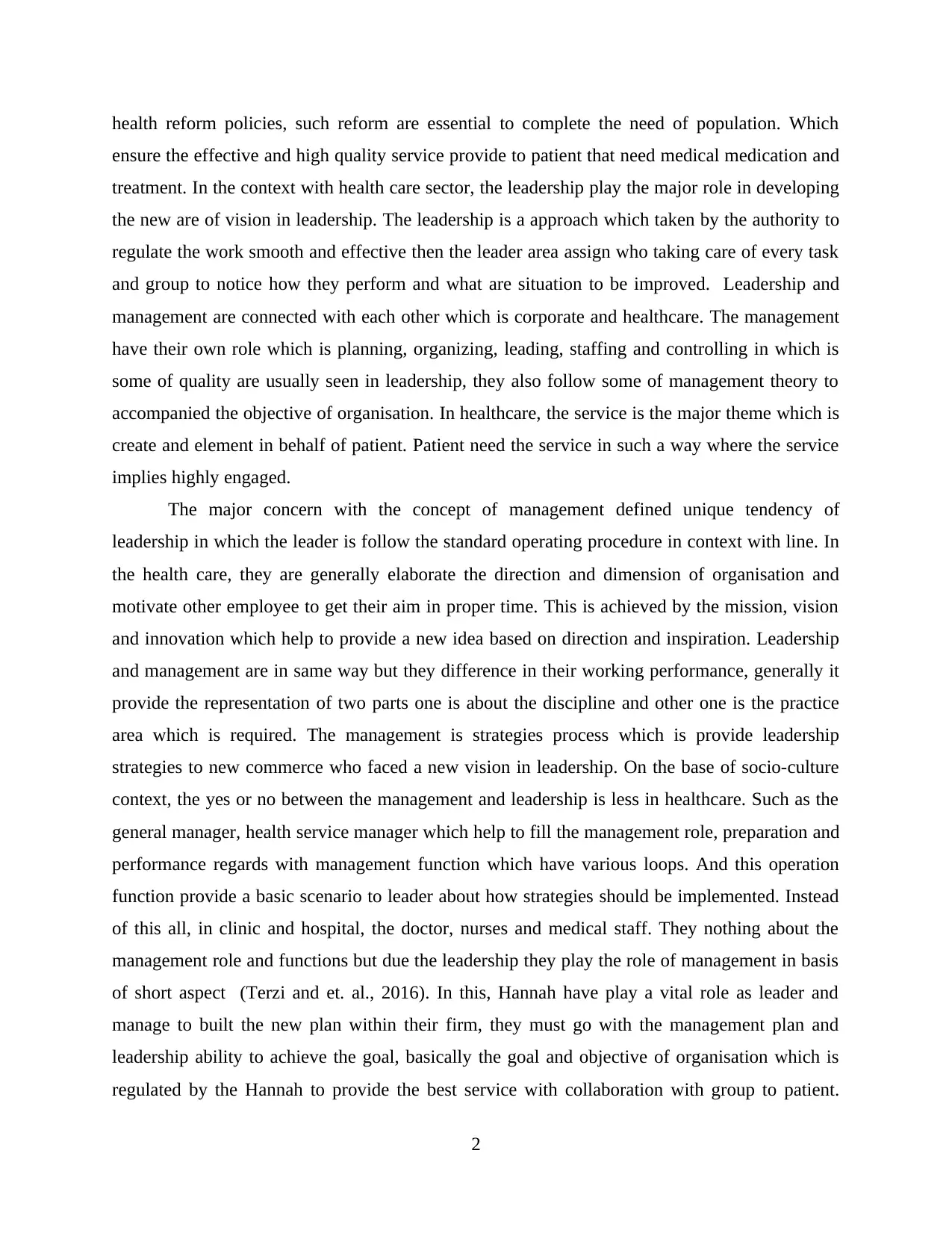
health reform policies, such reform are essential to complete the need of population. Which
ensure the effective and high quality service provide to patient that need medical medication and
treatment. In the context with health care sector, the leadership play the major role in developing
the new are of vision in leadership. The leadership is a approach which taken by the authority to
regulate the work smooth and effective then the leader area assign who taking care of every task
and group to notice how they perform and what are situation to be improved. Leadership and
management are connected with each other which is corporate and healthcare. The management
have their own role which is planning, organizing, leading, staffing and controlling in which is
some of quality are usually seen in leadership, they also follow some of management theory to
accompanied the objective of organisation. In healthcare, the service is the major theme which is
create and element in behalf of patient. Patient need the service in such a way where the service
implies highly engaged.
The major concern with the concept of management defined unique tendency of
leadership in which the leader is follow the standard operating procedure in context with line. In
the health care, they are generally elaborate the direction and dimension of organisation and
motivate other employee to get their aim in proper time. This is achieved by the mission, vision
and innovation which help to provide a new idea based on direction and inspiration. Leadership
and management are in same way but they difference in their working performance, generally it
provide the representation of two parts one is about the discipline and other one is the practice
area which is required. The management is strategies process which is provide leadership
strategies to new commerce who faced a new vision in leadership. On the base of socio-culture
context, the yes or no between the management and leadership is less in healthcare. Such as the
general manager, health service manager which help to fill the management role, preparation and
performance regards with management function which have various loops. And this operation
function provide a basic scenario to leader about how strategies should be implemented. Instead
of this all, in clinic and hospital, the doctor, nurses and medical staff. They nothing about the
management role and functions but due the leadership they play the role of management in basis
of short aspect (Terzi and et. al., 2016). In this, Hannah have play a vital role as leader and
manage to built the new plan within their firm, they must go with the management plan and
leadership ability to achieve the goal, basically the goal and objective of organisation which is
regulated by the Hannah to provide the best service with collaboration with group to patient.
2
ensure the effective and high quality service provide to patient that need medical medication and
treatment. In the context with health care sector, the leadership play the major role in developing
the new are of vision in leadership. The leadership is a approach which taken by the authority to
regulate the work smooth and effective then the leader area assign who taking care of every task
and group to notice how they perform and what are situation to be improved. Leadership and
management are connected with each other which is corporate and healthcare. The management
have their own role which is planning, organizing, leading, staffing and controlling in which is
some of quality are usually seen in leadership, they also follow some of management theory to
accompanied the objective of organisation. In healthcare, the service is the major theme which is
create and element in behalf of patient. Patient need the service in such a way where the service
implies highly engaged.
The major concern with the concept of management defined unique tendency of
leadership in which the leader is follow the standard operating procedure in context with line. In
the health care, they are generally elaborate the direction and dimension of organisation and
motivate other employee to get their aim in proper time. This is achieved by the mission, vision
and innovation which help to provide a new idea based on direction and inspiration. Leadership
and management are in same way but they difference in their working performance, generally it
provide the representation of two parts one is about the discipline and other one is the practice
area which is required. The management is strategies process which is provide leadership
strategies to new commerce who faced a new vision in leadership. On the base of socio-culture
context, the yes or no between the management and leadership is less in healthcare. Such as the
general manager, health service manager which help to fill the management role, preparation and
performance regards with management function which have various loops. And this operation
function provide a basic scenario to leader about how strategies should be implemented. Instead
of this all, in clinic and hospital, the doctor, nurses and medical staff. They nothing about the
management role and functions but due the leadership they play the role of management in basis
of short aspect (Terzi and et. al., 2016). In this, Hannah have play a vital role as leader and
manage to built the new plan within their firm, they must go with the management plan and
leadership ability to achieve the goal, basically the goal and objective of organisation which is
regulated by the Hannah to provide the best service with collaboration with group to patient.
2
Paraphrase This Document
Need a fresh take? Get an instant paraphrase of this document with our AI Paraphraser
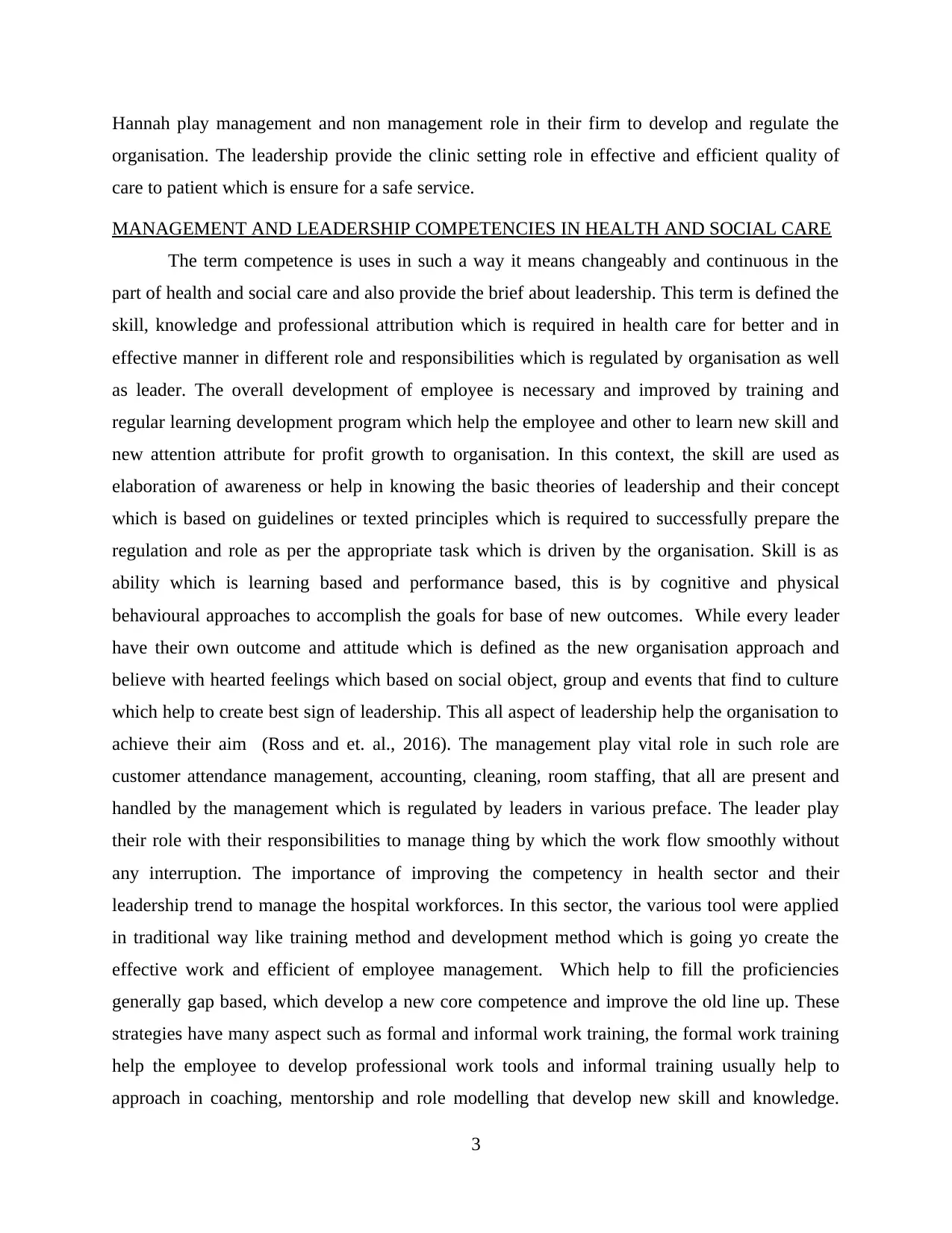
Hannah play management and non management role in their firm to develop and regulate the
organisation. The leadership provide the clinic setting role in effective and efficient quality of
care to patient which is ensure for a safe service.
MANAGEMENT AND LEADERSHIP COMPETENCIES IN HEALTH AND SOCIAL CARE
The term competence is uses in such a way it means changeably and continuous in the
part of health and social care and also provide the brief about leadership. This term is defined the
skill, knowledge and professional attribution which is required in health care for better and in
effective manner in different role and responsibilities which is regulated by organisation as well
as leader. The overall development of employee is necessary and improved by training and
regular learning development program which help the employee and other to learn new skill and
new attention attribute for profit growth to organisation. In this context, the skill are used as
elaboration of awareness or help in knowing the basic theories of leadership and their concept
which is based on guidelines or texted principles which is required to successfully prepare the
regulation and role as per the appropriate task which is driven by the organisation. Skill is as
ability which is learning based and performance based, this is by cognitive and physical
behavioural approaches to accomplish the goals for base of new outcomes. While every leader
have their own outcome and attitude which is defined as the new organisation approach and
believe with hearted feelings which based on social object, group and events that find to culture
which help to create best sign of leadership. This all aspect of leadership help the organisation to
achieve their aim (Ross and et. al., 2016). The management play vital role in such role are
customer attendance management, accounting, cleaning, room staffing, that all are present and
handled by the management which is regulated by leaders in various preface. The leader play
their role with their responsibilities to manage thing by which the work flow smoothly without
any interruption. The importance of improving the competency in health sector and their
leadership trend to manage the hospital workforces. In this sector, the various tool were applied
in traditional way like training method and development method which is going yo create the
effective work and efficient of employee management. Which help to fill the proficiencies
generally gap based, which develop a new core competence and improve the old line up. These
strategies have many aspect such as formal and informal work training, the formal work training
help the employee to develop professional work tools and informal training usually help to
approach in coaching, mentorship and role modelling that develop new skill and knowledge.
3
organisation. The leadership provide the clinic setting role in effective and efficient quality of
care to patient which is ensure for a safe service.
MANAGEMENT AND LEADERSHIP COMPETENCIES IN HEALTH AND SOCIAL CARE
The term competence is uses in such a way it means changeably and continuous in the
part of health and social care and also provide the brief about leadership. This term is defined the
skill, knowledge and professional attribution which is required in health care for better and in
effective manner in different role and responsibilities which is regulated by organisation as well
as leader. The overall development of employee is necessary and improved by training and
regular learning development program which help the employee and other to learn new skill and
new attention attribute for profit growth to organisation. In this context, the skill are used as
elaboration of awareness or help in knowing the basic theories of leadership and their concept
which is based on guidelines or texted principles which is required to successfully prepare the
regulation and role as per the appropriate task which is driven by the organisation. Skill is as
ability which is learning based and performance based, this is by cognitive and physical
behavioural approaches to accomplish the goals for base of new outcomes. While every leader
have their own outcome and attitude which is defined as the new organisation approach and
believe with hearted feelings which based on social object, group and events that find to culture
which help to create best sign of leadership. This all aspect of leadership help the organisation to
achieve their aim (Ross and et. al., 2016). The management play vital role in such role are
customer attendance management, accounting, cleaning, room staffing, that all are present and
handled by the management which is regulated by leaders in various preface. The leader play
their role with their responsibilities to manage thing by which the work flow smoothly without
any interruption. The importance of improving the competency in health sector and their
leadership trend to manage the hospital workforces. In this sector, the various tool were applied
in traditional way like training method and development method which is going yo create the
effective work and efficient of employee management. Which help to fill the proficiencies
generally gap based, which develop a new core competence and improve the old line up. These
strategies have many aspect such as formal and informal work training, the formal work training
help the employee to develop professional work tools and informal training usually help to
approach in coaching, mentorship and role modelling that develop new skill and knowledge.
3
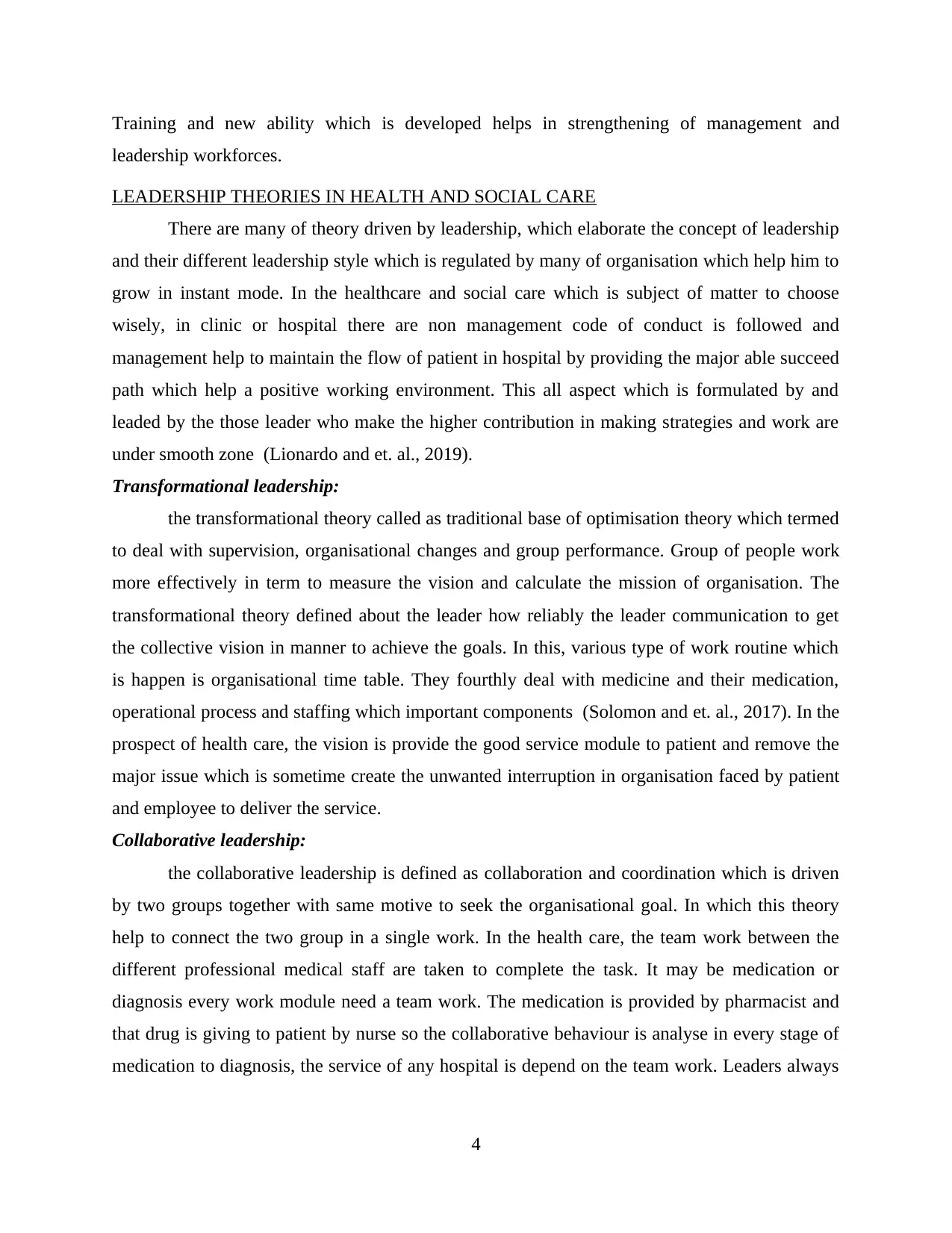
Training and new ability which is developed helps in strengthening of management and
leadership workforces.
LEADERSHIP THEORIES IN HEALTH AND SOCIAL CARE
There are many of theory driven by leadership, which elaborate the concept of leadership
and their different leadership style which is regulated by many of organisation which help him to
grow in instant mode. In the healthcare and social care which is subject of matter to choose
wisely, in clinic or hospital there are non management code of conduct is followed and
management help to maintain the flow of patient in hospital by providing the major able succeed
path which help a positive working environment. This all aspect which is formulated by and
leaded by the those leader who make the higher contribution in making strategies and work are
under smooth zone (Lionardo and et. al., 2019).
Transformational leadership:
the transformational theory called as traditional base of optimisation theory which termed
to deal with supervision, organisational changes and group performance. Group of people work
more effectively in term to measure the vision and calculate the mission of organisation. The
transformational theory defined about the leader how reliably the leader communication to get
the collective vision in manner to achieve the goals. In this, various type of work routine which
is happen is organisational time table. They fourthly deal with medicine and their medication,
operational process and staffing which important components (Solomon and et. al., 2017). In the
prospect of health care, the vision is provide the good service module to patient and remove the
major issue which is sometime create the unwanted interruption in organisation faced by patient
and employee to deliver the service.
Collaborative leadership:
the collaborative leadership is defined as collaboration and coordination which is driven
by two groups together with same motive to seek the organisational goal. In which this theory
help to connect the two group in a single work. In the health care, the team work between the
different professional medical staff are taken to complete the task. It may be medication or
diagnosis every work module need a team work. The medication is provided by pharmacist and
that drug is giving to patient by nurse so the collaborative behaviour is analyse in every stage of
medication to diagnosis, the service of any hospital is depend on the team work. Leaders always
4
leadership workforces.
LEADERSHIP THEORIES IN HEALTH AND SOCIAL CARE
There are many of theory driven by leadership, which elaborate the concept of leadership
and their different leadership style which is regulated by many of organisation which help him to
grow in instant mode. In the healthcare and social care which is subject of matter to choose
wisely, in clinic or hospital there are non management code of conduct is followed and
management help to maintain the flow of patient in hospital by providing the major able succeed
path which help a positive working environment. This all aspect which is formulated by and
leaded by the those leader who make the higher contribution in making strategies and work are
under smooth zone (Lionardo and et. al., 2019).
Transformational leadership:
the transformational theory called as traditional base of optimisation theory which termed
to deal with supervision, organisational changes and group performance. Group of people work
more effectively in term to measure the vision and calculate the mission of organisation. The
transformational theory defined about the leader how reliably the leader communication to get
the collective vision in manner to achieve the goals. In this, various type of work routine which
is happen is organisational time table. They fourthly deal with medicine and their medication,
operational process and staffing which important components (Solomon and et. al., 2017). In the
prospect of health care, the vision is provide the good service module to patient and remove the
major issue which is sometime create the unwanted interruption in organisation faced by patient
and employee to deliver the service.
Collaborative leadership:
the collaborative leadership is defined as collaboration and coordination which is driven
by two groups together with same motive to seek the organisational goal. In which this theory
help to connect the two group in a single work. In the health care, the team work between the
different professional medical staff are taken to complete the task. It may be medication or
diagnosis every work module need a team work. The medication is provided by pharmacist and
that drug is giving to patient by nurse so the collaborative behaviour is analyse in every stage of
medication to diagnosis, the service of any hospital is depend on the team work. Leaders always
4
⊘ This is a preview!⊘
Do you want full access?
Subscribe today to unlock all pages.

Trusted by 1+ million students worldwide
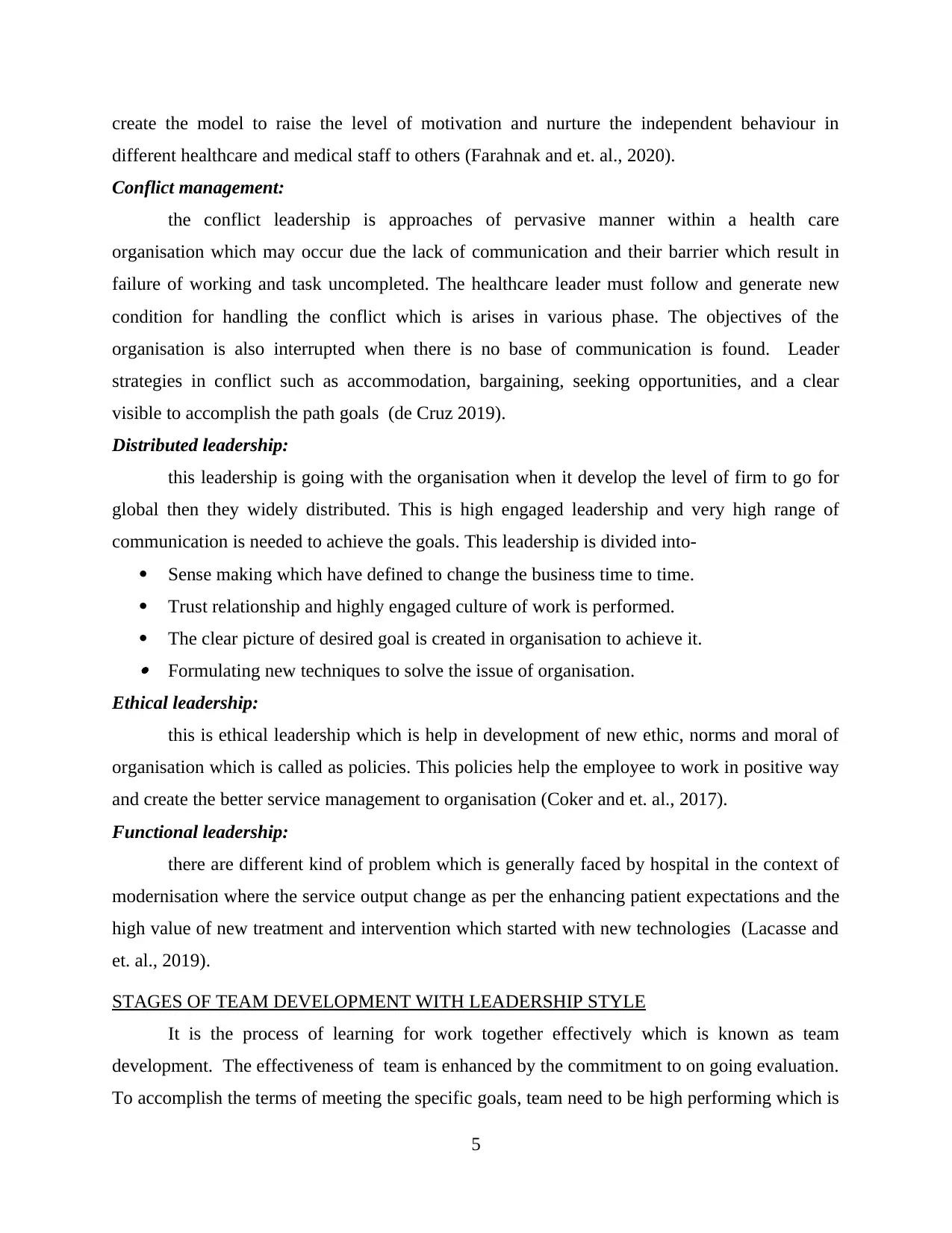
create the model to raise the level of motivation and nurture the independent behaviour in
different healthcare and medical staff to others (Farahnak and et. al., 2020).
Conflict management:
the conflict leadership is approaches of pervasive manner within a health care
organisation which may occur due the lack of communication and their barrier which result in
failure of working and task uncompleted. The healthcare leader must follow and generate new
condition for handling the conflict which is arises in various phase. The objectives of the
organisation is also interrupted when there is no base of communication is found. Leader
strategies in conflict such as accommodation, bargaining, seeking opportunities, and a clear
visible to accomplish the path goals (de Cruz 2019).
Distributed leadership:
this leadership is going with the organisation when it develop the level of firm to go for
global then they widely distributed. This is high engaged leadership and very high range of
communication is needed to achieve the goals. This leadership is divided into-
Sense making which have defined to change the business time to time.
Trust relationship and highly engaged culture of work is performed.
The clear picture of desired goal is created in organisation to achieve it. Formulating new techniques to solve the issue of organisation.
Ethical leadership:
this is ethical leadership which is help in development of new ethic, norms and moral of
organisation which is called as policies. This policies help the employee to work in positive way
and create the better service management to organisation (Coker and et. al., 2017).
Functional leadership:
there are different kind of problem which is generally faced by hospital in the context of
modernisation where the service output change as per the enhancing patient expectations and the
high value of new treatment and intervention which started with new technologies (Lacasse and
et. al., 2019).
STAGES OF TEAM DEVELOPMENT WITH LEADERSHIP STYLE
It is the process of learning for work together effectively which is known as team
development. The effectiveness of team is enhanced by the commitment to on going evaluation.
To accomplish the terms of meeting the specific goals, team need to be high performing which is
5
different healthcare and medical staff to others (Farahnak and et. al., 2020).
Conflict management:
the conflict leadership is approaches of pervasive manner within a health care
organisation which may occur due the lack of communication and their barrier which result in
failure of working and task uncompleted. The healthcare leader must follow and generate new
condition for handling the conflict which is arises in various phase. The objectives of the
organisation is also interrupted when there is no base of communication is found. Leader
strategies in conflict such as accommodation, bargaining, seeking opportunities, and a clear
visible to accomplish the path goals (de Cruz 2019).
Distributed leadership:
this leadership is going with the organisation when it develop the level of firm to go for
global then they widely distributed. This is high engaged leadership and very high range of
communication is needed to achieve the goals. This leadership is divided into-
Sense making which have defined to change the business time to time.
Trust relationship and highly engaged culture of work is performed.
The clear picture of desired goal is created in organisation to achieve it. Formulating new techniques to solve the issue of organisation.
Ethical leadership:
this is ethical leadership which is help in development of new ethic, norms and moral of
organisation which is called as policies. This policies help the employee to work in positive way
and create the better service management to organisation (Coker and et. al., 2017).
Functional leadership:
there are different kind of problem which is generally faced by hospital in the context of
modernisation where the service output change as per the enhancing patient expectations and the
high value of new treatment and intervention which started with new technologies (Lacasse and
et. al., 2019).
STAGES OF TEAM DEVELOPMENT WITH LEADERSHIP STYLE
It is the process of learning for work together effectively which is known as team
development. The effectiveness of team is enhanced by the commitment to on going evaluation.
To accomplish the terms of meeting the specific goals, team need to be high performing which is
5
Paraphrase This Document
Need a fresh take? Get an instant paraphrase of this document with our AI Paraphraser
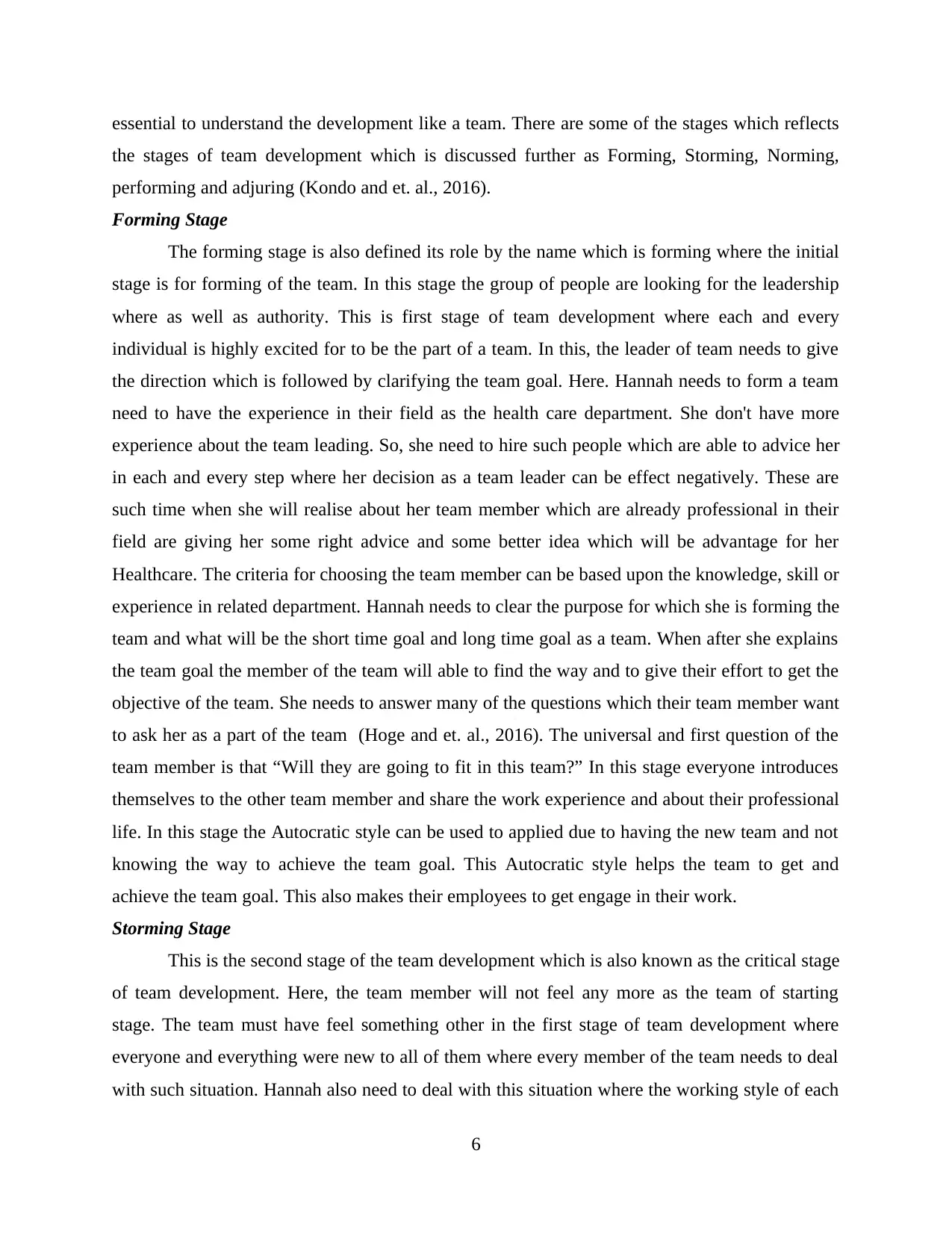
essential to understand the development like a team. There are some of the stages which reflects
the stages of team development which is discussed further as Forming, Storming, Norming,
performing and adjuring (Kondo and et. al., 2016).
Forming Stage
The forming stage is also defined its role by the name which is forming where the initial
stage is for forming of the team. In this stage the group of people are looking for the leadership
where as well as authority. This is first stage of team development where each and every
individual is highly excited for to be the part of a team. In this, the leader of team needs to give
the direction which is followed by clarifying the team goal. Here. Hannah needs to form a team
need to have the experience in their field as the health care department. She don't have more
experience about the team leading. So, she need to hire such people which are able to advice her
in each and every step where her decision as a team leader can be effect negatively. These are
such time when she will realise about her team member which are already professional in their
field are giving her some right advice and some better idea which will be advantage for her
Healthcare. The criteria for choosing the team member can be based upon the knowledge, skill or
experience in related department. Hannah needs to clear the purpose for which she is forming the
team and what will be the short time goal and long time goal as a team. When after she explains
the team goal the member of the team will able to find the way and to give their effort to get the
objective of the team. She needs to answer many of the questions which their team member want
to ask her as a part of the team (Hoge and et. al., 2016). The universal and first question of the
team member is that “Will they are going to fit in this team?” In this stage everyone introduces
themselves to the other team member and share the work experience and about their professional
life. In this stage the Autocratic style can be used to applied due to having the new team and not
knowing the way to achieve the team goal. This Autocratic style helps the team to get and
achieve the team goal. This also makes their employees to get engage in their work.
Storming Stage
This is the second stage of the team development which is also known as the critical stage
of team development. Here, the team member will not feel any more as the team of starting
stage. The team must have feel something other in the first stage of team development where
everyone and everything were new to all of them where every member of the team needs to deal
with such situation. Hannah also need to deal with this situation where the working style of each
6
the stages of team development which is discussed further as Forming, Storming, Norming,
performing and adjuring (Kondo and et. al., 2016).
Forming Stage
The forming stage is also defined its role by the name which is forming where the initial
stage is for forming of the team. In this stage the group of people are looking for the leadership
where as well as authority. This is first stage of team development where each and every
individual is highly excited for to be the part of a team. In this, the leader of team needs to give
the direction which is followed by clarifying the team goal. Here. Hannah needs to form a team
need to have the experience in their field as the health care department. She don't have more
experience about the team leading. So, she need to hire such people which are able to advice her
in each and every step where her decision as a team leader can be effect negatively. These are
such time when she will realise about her team member which are already professional in their
field are giving her some right advice and some better idea which will be advantage for her
Healthcare. The criteria for choosing the team member can be based upon the knowledge, skill or
experience in related department. Hannah needs to clear the purpose for which she is forming the
team and what will be the short time goal and long time goal as a team. When after she explains
the team goal the member of the team will able to find the way and to give their effort to get the
objective of the team. She needs to answer many of the questions which their team member want
to ask her as a part of the team (Hoge and et. al., 2016). The universal and first question of the
team member is that “Will they are going to fit in this team?” In this stage everyone introduces
themselves to the other team member and share the work experience and about their professional
life. In this stage the Autocratic style can be used to applied due to having the new team and not
knowing the way to achieve the team goal. This Autocratic style helps the team to get and
achieve the team goal. This also makes their employees to get engage in their work.
Storming Stage
This is the second stage of the team development which is also known as the critical stage
of team development. Here, the team member will not feel any more as the team of starting
stage. The team must have feel something other in the first stage of team development where
everyone and everything were new to all of them where every member of the team needs to deal
with such situation. Hannah also need to deal with this situation where the working style of each
6
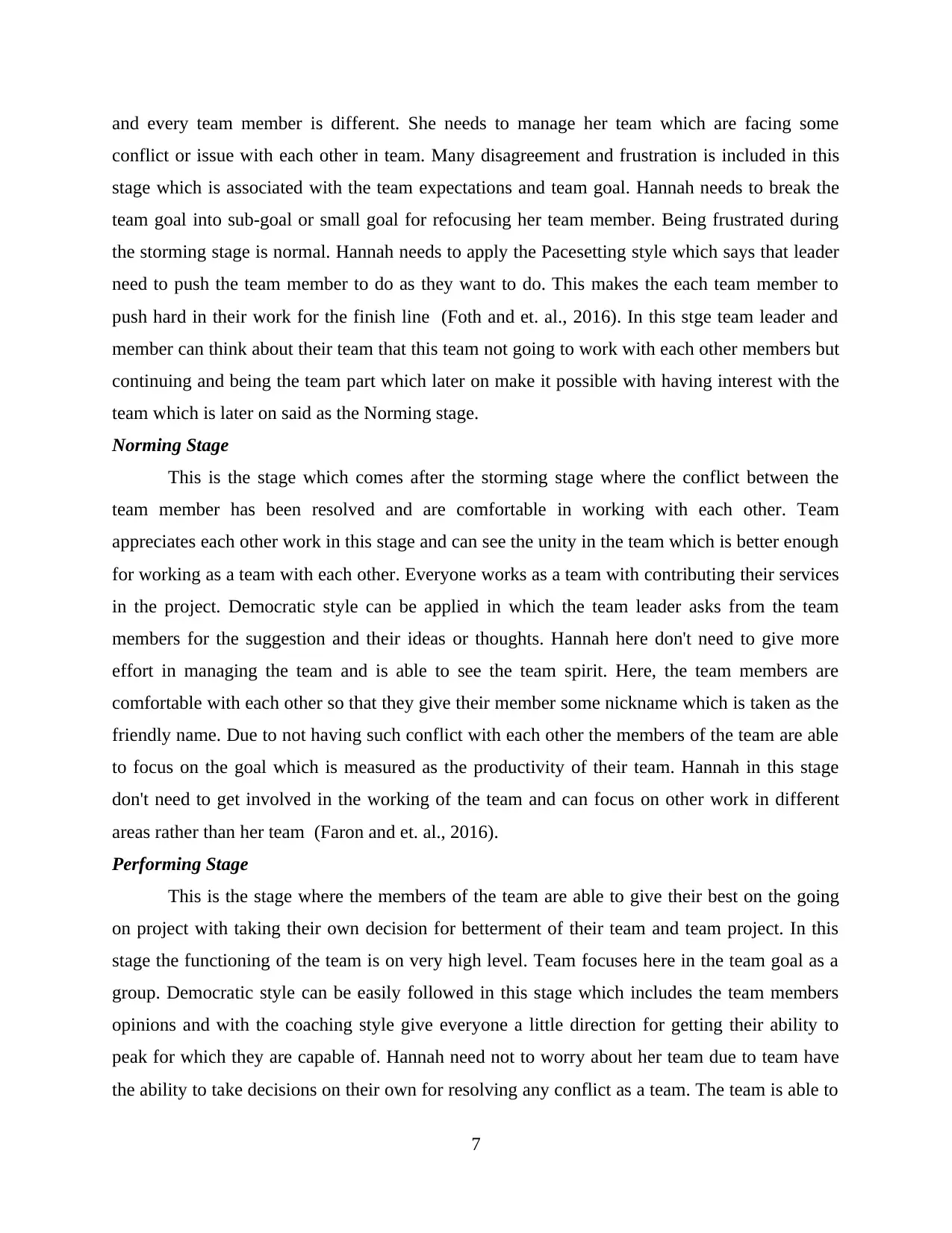
and every team member is different. She needs to manage her team which are facing some
conflict or issue with each other in team. Many disagreement and frustration is included in this
stage which is associated with the team expectations and team goal. Hannah needs to break the
team goal into sub-goal or small goal for refocusing her team member. Being frustrated during
the storming stage is normal. Hannah needs to apply the Pacesetting style which says that leader
need to push the team member to do as they want to do. This makes the each team member to
push hard in their work for the finish line (Foth and et. al., 2016). In this stge team leader and
member can think about their team that this team not going to work with each other members but
continuing and being the team part which later on make it possible with having interest with the
team which is later on said as the Norming stage.
Norming Stage
This is the stage which comes after the storming stage where the conflict between the
team member has been resolved and are comfortable in working with each other. Team
appreciates each other work in this stage and can see the unity in the team which is better enough
for working as a team with each other. Everyone works as a team with contributing their services
in the project. Democratic style can be applied in which the team leader asks from the team
members for the suggestion and their ideas or thoughts. Hannah here don't need to give more
effort in managing the team and is able to see the team spirit. Here, the team members are
comfortable with each other so that they give their member some nickname which is taken as the
friendly name. Due to not having such conflict with each other the members of the team are able
to focus on the goal which is measured as the productivity of their team. Hannah in this stage
don't need to get involved in the working of the team and can focus on other work in different
areas rather than her team (Faron and et. al., 2016).
Performing Stage
This is the stage where the members of the team are able to give their best on the going
on project with taking their own decision for betterment of their team and team project. In this
stage the functioning of the team is on very high level. Team focuses here in the team goal as a
group. Democratic style can be easily followed in this stage which includes the team members
opinions and with the coaching style give everyone a little direction for getting their ability to
peak for which they are capable of. Hannah need not to worry about her team due to team have
the ability to take decisions on their own for resolving any conflict as a team. The team is able to
7
conflict or issue with each other in team. Many disagreement and frustration is included in this
stage which is associated with the team expectations and team goal. Hannah needs to break the
team goal into sub-goal or small goal for refocusing her team member. Being frustrated during
the storming stage is normal. Hannah needs to apply the Pacesetting style which says that leader
need to push the team member to do as they want to do. This makes the each team member to
push hard in their work for the finish line (Foth and et. al., 2016). In this stge team leader and
member can think about their team that this team not going to work with each other members but
continuing and being the team part which later on make it possible with having interest with the
team which is later on said as the Norming stage.
Norming Stage
This is the stage which comes after the storming stage where the conflict between the
team member has been resolved and are comfortable in working with each other. Team
appreciates each other work in this stage and can see the unity in the team which is better enough
for working as a team with each other. Everyone works as a team with contributing their services
in the project. Democratic style can be applied in which the team leader asks from the team
members for the suggestion and their ideas or thoughts. Hannah here don't need to give more
effort in managing the team and is able to see the team spirit. Here, the team members are
comfortable with each other so that they give their member some nickname which is taken as the
friendly name. Due to not having such conflict with each other the members of the team are able
to focus on the goal which is measured as the productivity of their team. Hannah in this stage
don't need to get involved in the working of the team and can focus on other work in different
areas rather than her team (Faron and et. al., 2016).
Performing Stage
This is the stage where the members of the team are able to give their best on the going
on project with taking their own decision for betterment of their team and team project. In this
stage the functioning of the team is on very high level. Team focuses here in the team goal as a
group. Democratic style can be easily followed in this stage which includes the team members
opinions and with the coaching style give everyone a little direction for getting their ability to
peak for which they are capable of. Hannah need not to worry about her team due to team have
the ability to take decisions on their own for resolving any conflict as a team. The team is able to
7
⊘ This is a preview!⊘
Do you want full access?
Subscribe today to unlock all pages.

Trusted by 1+ million students worldwide
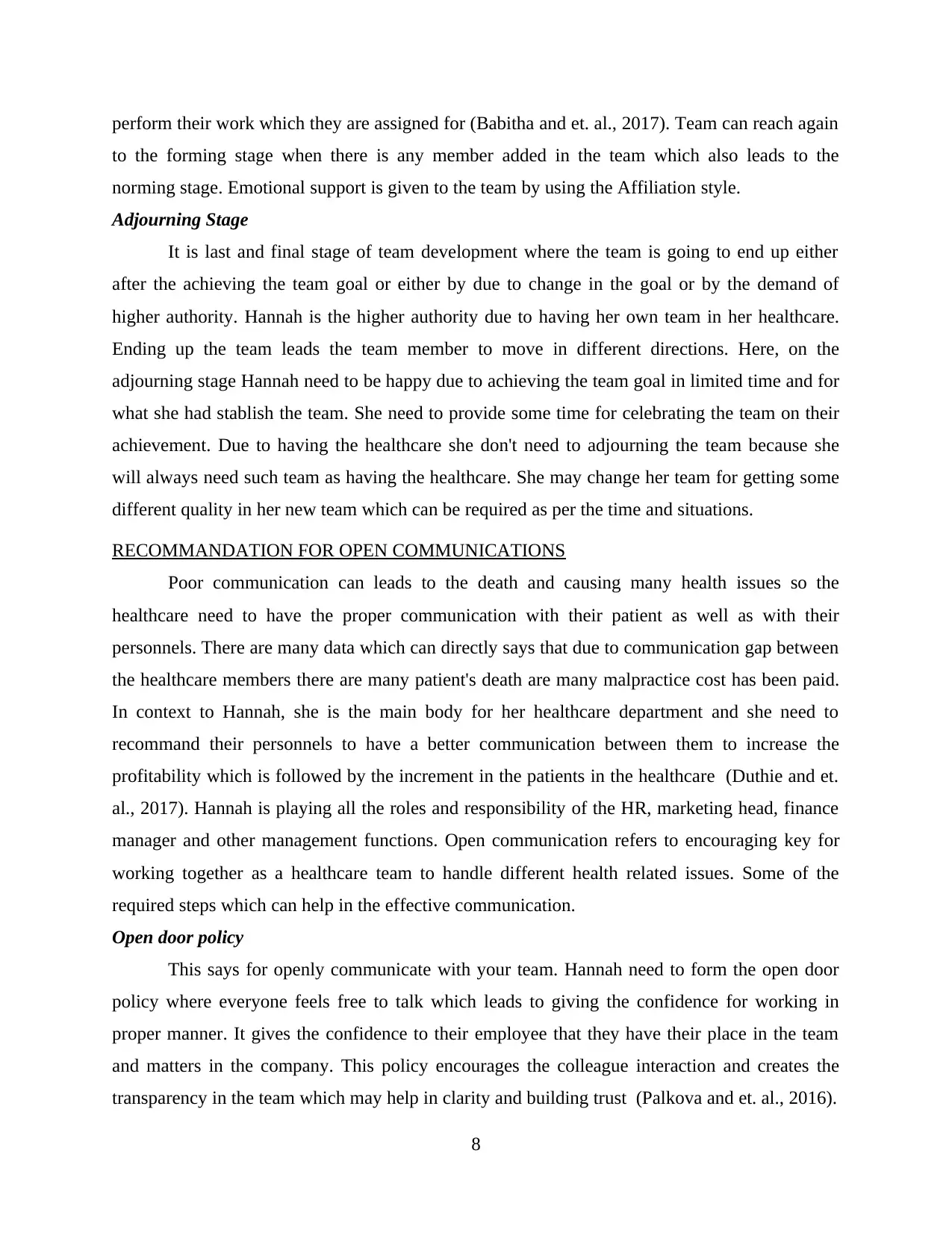
perform their work which they are assigned for (Babitha and et. al., 2017). Team can reach again
to the forming stage when there is any member added in the team which also leads to the
norming stage. Emotional support is given to the team by using the Affiliation style.
Adjourning Stage
It is last and final stage of team development where the team is going to end up either
after the achieving the team goal or either by due to change in the goal or by the demand of
higher authority. Hannah is the higher authority due to having her own team in her healthcare.
Ending up the team leads the team member to move in different directions. Here, on the
adjourning stage Hannah need to be happy due to achieving the team goal in limited time and for
what she had stablish the team. She need to provide some time for celebrating the team on their
achievement. Due to having the healthcare she don't need to adjourning the team because she
will always need such team as having the healthcare. She may change her team for getting some
different quality in her new team which can be required as per the time and situations.
RECOMMANDATION FOR OPEN COMMUNICATIONS
Poor communication can leads to the death and causing many health issues so the
healthcare need to have the proper communication with their patient as well as with their
personnels. There are many data which can directly says that due to communication gap between
the healthcare members there are many patient's death are many malpractice cost has been paid.
In context to Hannah, she is the main body for her healthcare department and she need to
recommand their personnels to have a better communication between them to increase the
profitability which is followed by the increment in the patients in the healthcare (Duthie and et.
al., 2017). Hannah is playing all the roles and responsibility of the HR, marketing head, finance
manager and other management functions. Open communication refers to encouraging key for
working together as a healthcare team to handle different health related issues. Some of the
required steps which can help in the effective communication.
Open door policy
This says for openly communicate with your team. Hannah need to form the open door
policy where everyone feels free to talk which leads to giving the confidence for working in
proper manner. It gives the confidence to their employee that they have their place in the team
and matters in the company. This policy encourages the colleague interaction and creates the
transparency in the team which may help in clarity and building trust (Palkova and et. al., 2016).
8
to the forming stage when there is any member added in the team which also leads to the
norming stage. Emotional support is given to the team by using the Affiliation style.
Adjourning Stage
It is last and final stage of team development where the team is going to end up either
after the achieving the team goal or either by due to change in the goal or by the demand of
higher authority. Hannah is the higher authority due to having her own team in her healthcare.
Ending up the team leads the team member to move in different directions. Here, on the
adjourning stage Hannah need to be happy due to achieving the team goal in limited time and for
what she had stablish the team. She need to provide some time for celebrating the team on their
achievement. Due to having the healthcare she don't need to adjourning the team because she
will always need such team as having the healthcare. She may change her team for getting some
different quality in her new team which can be required as per the time and situations.
RECOMMANDATION FOR OPEN COMMUNICATIONS
Poor communication can leads to the death and causing many health issues so the
healthcare need to have the proper communication with their patient as well as with their
personnels. There are many data which can directly says that due to communication gap between
the healthcare members there are many patient's death are many malpractice cost has been paid.
In context to Hannah, she is the main body for her healthcare department and she need to
recommand their personnels to have a better communication between them to increase the
profitability which is followed by the increment in the patients in the healthcare (Duthie and et.
al., 2017). Hannah is playing all the roles and responsibility of the HR, marketing head, finance
manager and other management functions. Open communication refers to encouraging key for
working together as a healthcare team to handle different health related issues. Some of the
required steps which can help in the effective communication.
Open door policy
This says for openly communicate with your team. Hannah need to form the open door
policy where everyone feels free to talk which leads to giving the confidence for working in
proper manner. It gives the confidence to their employee that they have their place in the team
and matters in the company. This policy encourages the colleague interaction and creates the
transparency in the team which may help in clarity and building trust (Palkova and et. al., 2016).
8
Paraphrase This Document
Need a fresh take? Get an instant paraphrase of this document with our AI Paraphraser
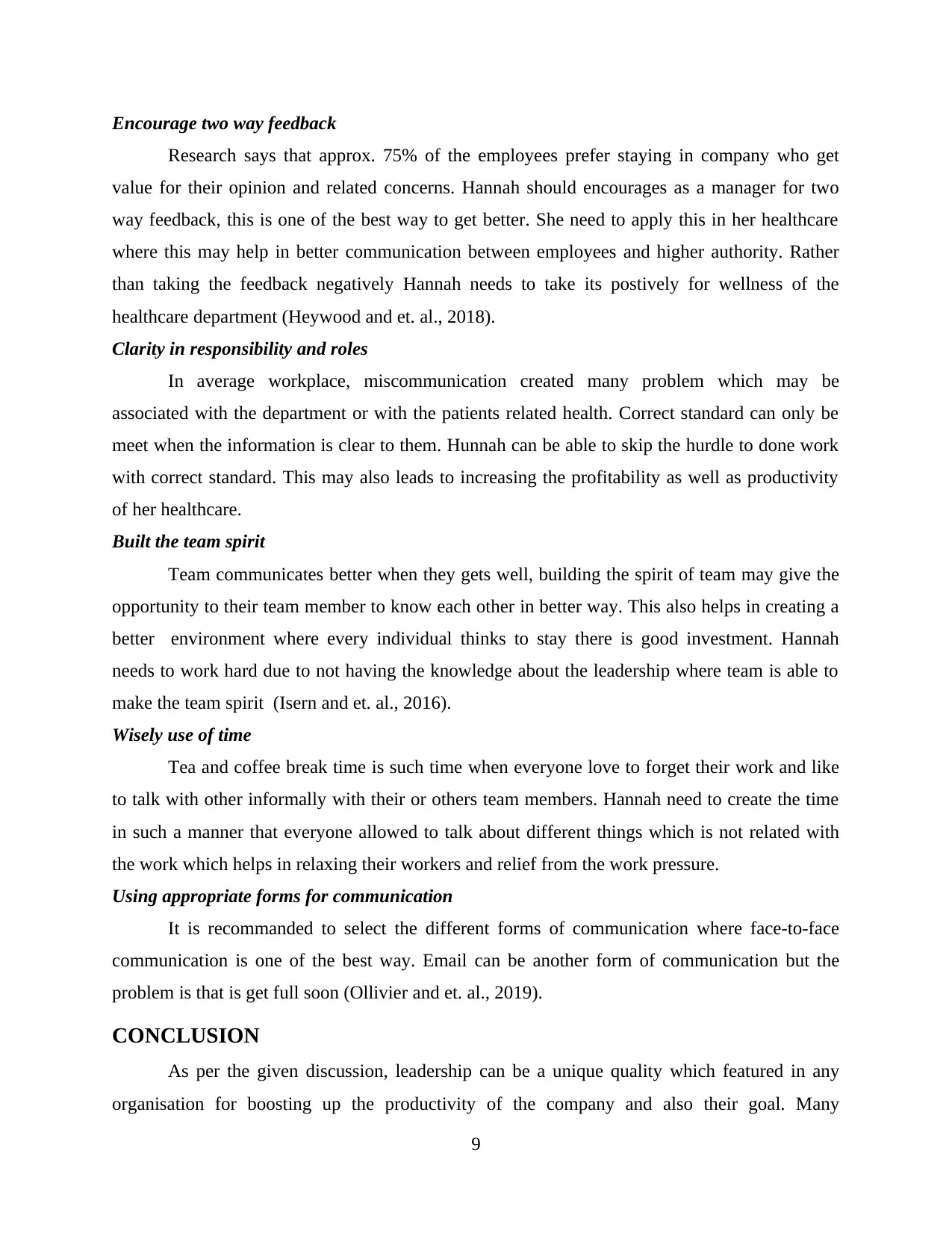
Encourage two way feedback
Research says that approx. 75% of the employees prefer staying in company who get
value for their opinion and related concerns. Hannah should encourages as a manager for two
way feedback, this is one of the best way to get better. She need to apply this in her healthcare
where this may help in better communication between employees and higher authority. Rather
than taking the feedback negatively Hannah needs to take its postively for wellness of the
healthcare department (Heywood and et. al., 2018).
Clarity in responsibility and roles
In average workplace, miscommunication created many problem which may be
associated with the department or with the patients related health. Correct standard can only be
meet when the information is clear to them. Hunnah can be able to skip the hurdle to done work
with correct standard. This may also leads to increasing the profitability as well as productivity
of her healthcare.
Built the team spirit
Team communicates better when they gets well, building the spirit of team may give the
opportunity to their team member to know each other in better way. This also helps in creating a
better environment where every individual thinks to stay there is good investment. Hannah
needs to work hard due to not having the knowledge about the leadership where team is able to
make the team spirit (Isern and et. al., 2016).
Wisely use of time
Tea and coffee break time is such time when everyone love to forget their work and like
to talk with other informally with their or others team members. Hannah need to create the time
in such a manner that everyone allowed to talk about different things which is not related with
the work which helps in relaxing their workers and relief from the work pressure.
Using appropriate forms for communication
It is recommanded to select the different forms of communication where face-to-face
communication is one of the best way. Email can be another form of communication but the
problem is that is get full soon (Ollivier and et. al., 2019).
CONCLUSION
As per the given discussion, leadership can be a unique quality which featured in any
organisation for boosting up the productivity of the company and also their goal. Many
9
Research says that approx. 75% of the employees prefer staying in company who get
value for their opinion and related concerns. Hannah should encourages as a manager for two
way feedback, this is one of the best way to get better. She need to apply this in her healthcare
where this may help in better communication between employees and higher authority. Rather
than taking the feedback negatively Hannah needs to take its postively for wellness of the
healthcare department (Heywood and et. al., 2018).
Clarity in responsibility and roles
In average workplace, miscommunication created many problem which may be
associated with the department or with the patients related health. Correct standard can only be
meet when the information is clear to them. Hunnah can be able to skip the hurdle to done work
with correct standard. This may also leads to increasing the profitability as well as productivity
of her healthcare.
Built the team spirit
Team communicates better when they gets well, building the spirit of team may give the
opportunity to their team member to know each other in better way. This also helps in creating a
better environment where every individual thinks to stay there is good investment. Hannah
needs to work hard due to not having the knowledge about the leadership where team is able to
make the team spirit (Isern and et. al., 2016).
Wisely use of time
Tea and coffee break time is such time when everyone love to forget their work and like
to talk with other informally with their or others team members. Hannah need to create the time
in such a manner that everyone allowed to talk about different things which is not related with
the work which helps in relaxing their workers and relief from the work pressure.
Using appropriate forms for communication
It is recommanded to select the different forms of communication where face-to-face
communication is one of the best way. Email can be another form of communication but the
problem is that is get full soon (Ollivier and et. al., 2019).
CONCLUSION
As per the given discussion, leadership can be a unique quality which featured in any
organisation for boosting up the productivity of the company and also their goal. Many
9
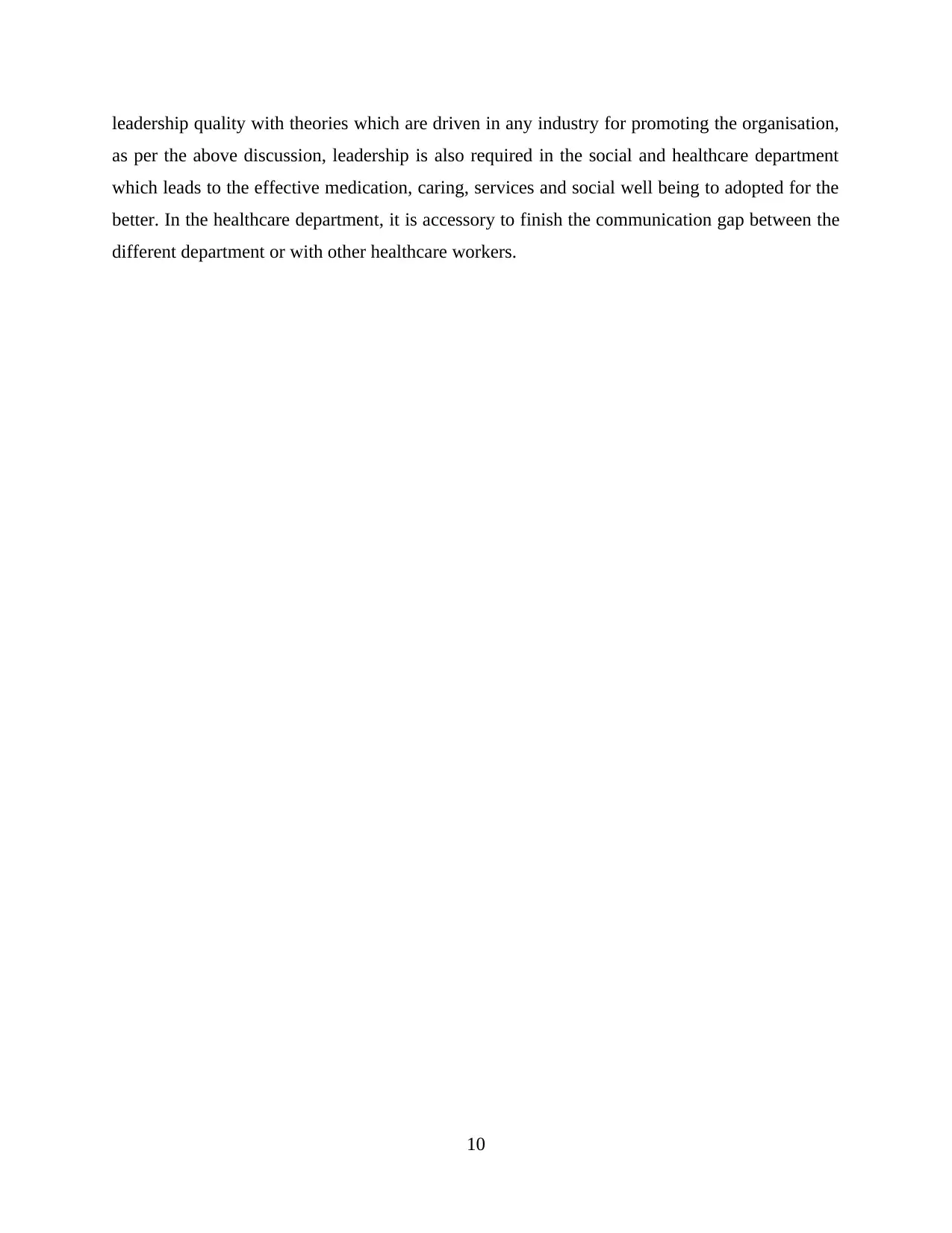
leadership quality with theories which are driven in any industry for promoting the organisation,
as per the above discussion, leadership is also required in the social and healthcare department
which leads to the effective medication, caring, services and social well being to adopted for the
better. In the healthcare department, it is accessory to finish the communication gap between the
different department or with other healthcare workers.
10
as per the above discussion, leadership is also required in the social and healthcare department
which leads to the effective medication, caring, services and social well being to adopted for the
better. In the healthcare department, it is accessory to finish the communication gap between the
different department or with other healthcare workers.
10
⊘ This is a preview!⊘
Do you want full access?
Subscribe today to unlock all pages.

Trusted by 1+ million students worldwide
1 out of 14
Related Documents
Your All-in-One AI-Powered Toolkit for Academic Success.
+13062052269
info@desklib.com
Available 24*7 on WhatsApp / Email
![[object Object]](/_next/static/media/star-bottom.7253800d.svg)
Unlock your academic potential
Copyright © 2020–2025 A2Z Services. All Rights Reserved. Developed and managed by ZUCOL.



